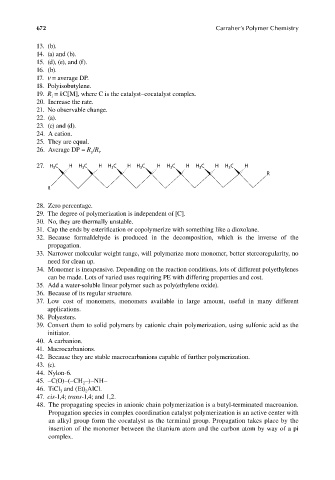Page 709 - Carrahers_Polymer_Chemistry,_Eighth_Edition
P. 709
672 Carraher’s Polymer Chemistry
13. (b).
14. (a) and (b).
15. (d), (e), and (f).
16. (b).
17. ν = average DP.
18. Polyisobutylene.
19. R = kC[M], where C is the catalyst–cocatalyst complex.
i
20. Increase the rate.
21. No observable change.
22. (a).
23. (c) and (d).
24. A cation.
25. They are equal.
26. Average DP = R /R .
p t
27. H C H H C H H C H H C H H C H H C H H C H
3
3
3
3
3
3
3
R
R
28. Zero percentage.
29. The degree of polymerization is independent of [C].
30. No, they are thermally unstable.
31. Cap the ends by esterification or copolymerize with something like a dioxolane.
32. Because formaldehyde is produced in the decomposition, which is the inverse of the
propagation.
33. Narrower molecular weight range, will polymerize more monomer, better stereoregularity, no
need for clean up.
34. Monomer is inexpensive. Depending on the reaction conditions, lots of different polyethylenes
can be made. Lots of varied uses requiring PE with differing properties and cost.
35. Add a water-soluble linear polymer such as poly(ethylene oxide).
36. Because of its regular structure.
37. Low cost of monomers, monomers available in large amount, useful in many different
applications.
38. Polyesters.
39. Convert them to solid polymers by cationic chain polymerization, using sulfonic acid as the
initiator.
40. A carbanion.
41. Macrocarbanions.
42. Because they are stable macrocarbanions capable of further polymerization.
43. (c).
44. Nylon-6.
45. –C(O)–(–CH –)–NH–
2
46. TiCl and (Et) AlCl.
2
3
47. cis-1,4; trans-1,4; and 1,2.
48. The propagating species in anionic chain polymerization is a butyl-terminated macroanion.
Propagation species in complex coordination catalyst polymerization is an active center with
an alkyl group form the cocatalyst as the terminal group. Propagation takes place by the
insertion of the monomer between the titanium atom and the carbon atom by way of a pi
complex.
9/14/2010 3:44:15 PM
K10478.indb 672 9/14/2010 3:44:15 PM
K10478.indb 672

